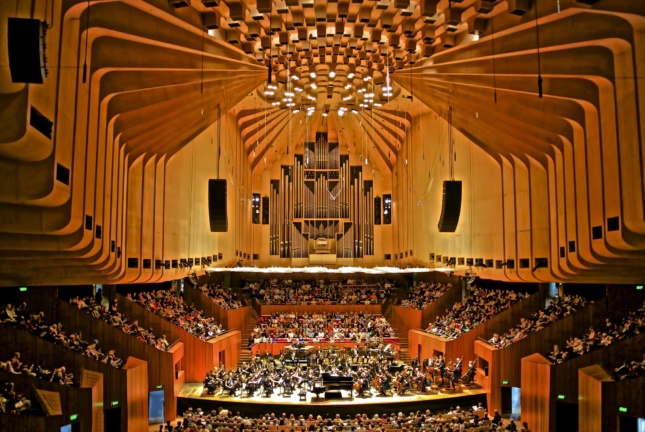Like many great cultural institutions the world over, the Sydney Opera House is currently closed to the public as the spread of coronavirus (COVID-19) brings life in major population centers to a standstill.
The closure of the iconic Sydney Opera House’s Concert Hall, however, was a pre-planned and long-awaited maneuver to accommodate a much-needed rehabilitation of the acoustically challenged, accessibility-plagued venue. Renovation work first kicked off in February, marking the first time in its history that the Concert Hall has gone dark for an extended period. Per the New York Times, the gall and the surrounding Opera House complex are normally open to the public 363 days a year.
A January 31 performance by Solange was the last held there for at least the next two years.
Pending any delays, the 2,500-seat venue is expected to reopen in mid-2021, ahead of the Opera House’s 50th anniversary in 2023. (Other performances and gatherings held in other venues at the concrete sail-topped Opera House complex that were to remain open during the revamp have since been postponed as a proactive measure against the spread of COVID-19.)
Sporting a price tag of $200 million that’s being covered by the New South Wales government, the Concert Hall refurbishment is a major endeavor that, after years of planning, will correct numerous shortcomings of the famous—and famously flawed—venue. The upgrades will tackle not-so-insignificant issues with sound quality, performance logistics, and guest accessibility that have vexed Opera House officials, performers, and the general public alike for decades.

As the Times and others have noted, the UNESCO World Heritage Site-listed structure is one of the world’s most distinctive and instantly recognizable works of modern architecture. But its construction was a notoriously troubled one, complete with ballooning costs, scheduling overruns, technical missteps, bureaucratic in-fighting, a workers’ strike, and the resignation of its architect, Jørn Utzon, long before it was completed. While the interiors are visually ravishing thanks in large part to Utzon’s successor, Australian architect Peter Hall, the Concert Hall has long been regarded as subpar when it comes to its aural qualities—kind of important for a world-renowned concert venue.
Writes The Guardian:
“The actor John Malkovich once said the acoustics in the Concert Hall ‘would do an aeroplane hangar a disservice.’ Members of the resident Sydney Symphony Orchestra have long complained that they cannot hear their fellow musicians on stage. And the rise of the rock concert has further challenged the venue, with amplified music and electronic sets being precisely the opposite of what the hall’s infrastructure was built to accommodate.”
As The Guardian explains, these issues largely arise from the fact that the Concert Hall was initially designed to be more of a multipurpose space complete with overhead theatrical rigging that could accommodate opera and plays. But following Utzon’s departure, these types of performances were reassigned to a more intimate venue at the Opera House, the Joan Sutherland Theatre, and the grand hall was redesigned to exclusively accommodate classical music performances. While symphonies continue to dominate the space, it’s also now heavily—and imperfectly—used for rock, pop, and dance acts as well.
In addition to issues of bad acoustics, “more basic matters,” as the Times puts it, have long begged for fixing. This includes replacing antiquated electrical wiring and modernizing a rather inconvenient HVAC system.
“The air conditioning system is hopeless,” Rory Jeffes, the leader of Opera Australia and former managing director of the Sydney Symphony Orchestra, told the Times.“It blows out of cannon ports up above, and then falls onto the stage, and very often turns the pages of the musicians as they play.”
Improving accessibility for the million-plus visitors that the Opera House receives every year is also a top priority. While it’s a pressing matter today, how patrons with mobility issues traversed the sprawling, stair-heavy space wasn’t a main concern in the late 1960s and early 1970s when the building was being designed and constructed. Opening up the space to visitors of all ages and physical abilities has been a challenge, however, considering its designation as a historic landmark.
A major aspect of improving accessibility at the Concert Hall tasked to ARM Architecture, the Melbourne- and Sydney-based firm overseeing the project, has been installing elevators, something that didn’t exist before.
In addition to elevators and code-compliant accessibility tweaks, other upgrades include: a new acoustic ceiling, specially designed acoustic reflectors, new acoustic panels to be placed over the stage and elsewhere, an automatic drape system, automatic stage risers, a modernized theatrical grid system, revamped backstage areas, and more.
Explains ARM:
“The number and diversity of shows being staged in the Concert Hall, as well as their performance requirements, have increased enormously over the decades since the building first opened.
It is vital the Opera House invests in new technology and systems to ensure the venue continues to meet orchestral and contemporary performance needs and the expectations of staff, resident companies, performers, and audiences now and in the future.”
In executing the overhaul, ARM is working closely alongside a team of acousticians as well as engineering firms Arup and Steensen Varming to better “understand the building’s existing structural condition” before carrying out more complex aspects of the renovation. All upgrades and refurbishments are being carried out in accordance with the Opera House’s Conservation Management Plan and will respect Utzon’s original design principles.
“We need to not only maintain our fabulous heritage but we need to be as prepared as we possibly can be for the next 50 years,” Louise Herron, chief executive of the Sydney Opera House, told The Guardian. “What is it that audiences of now and the future are going to want and how can we best prepare the Concert Hall for that? That’s been the driving force behind our approach.”











